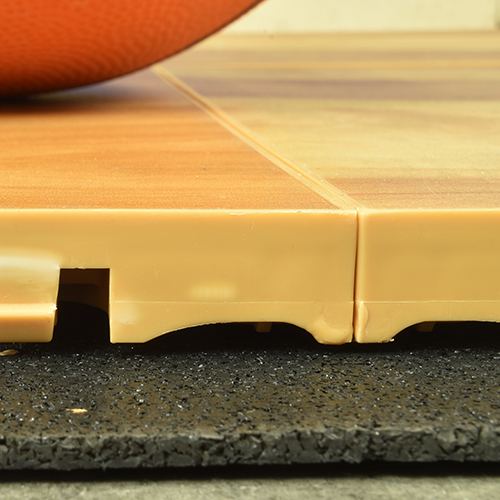ProCourt Snap Together Gym Floor Tiles for Sport Courts
Related Product: Basketball Court Tile Gym Floor Pro 9/16 Inch x 1x1 Ft.
A vinyl layer that looks like the hardwood court planks of a basketball or volleyball floor yields the precise design that installers will want. The vinyl flooring material attaches to a durable plastic base with an interlocking system for easy installation.
One of the most popular products for this use case is the Basketball Court Tile Gym Floor Pro product. Its individual tiles closely resemble maple hardwood basketball flooring that’d be found in a high school gym.
This style of basketball court flooring costs significantly less than the real thing, helping multi-purpose fitness centers, churches, and schools to fit this type of installation into a tight budget.
One of the best multi-sport flooring options, it gives athletes the sure footing they need for many kinds of indoor sports, including volleyball, badminton, indoor soccer, or activities in a physical education class.
Additionally, the high quality commercial vinyl surface layer measures 0.5 mm in thickness and it low-maintenance, ensuring it will not show wear and tear after repetitive use.
This basketball court flooring has a modular design, featuring hidden tabs and loops on the edges of the interlocking base. Installers simply pop the edges together to create a secure fit that will look great afterward.
What Is the Best Gym Flooring for a Basketball Court?
Certainly, gyms that can afford the price of actual maple hardwood planks -- along with the cost of hiring a professional to install them -- will appreciate the look and level of performance they receive from a real-wood basketball court flooring.However, when trying to create a court that is easy to install and that even has a portable component, the Court Tile floor tiles mentioned earlier are an excellent choice.
The plastic base with the hidden interlocking edge provides excellent durability. It’s made for hundreds of assemblies and disassemblies, so facilities can lay out the floor for an event and disassemble it afterward repeatedly.
Each tile has a size of 1 by 1 feet and weighs only 2 pounds, so a single person can handle the installation process with ease.
This is a highly durable tile, offering a 5-year limited manufacturer warranty. Installers receive an excellent value over the long haul.
How Much Does a Basketball Court Floor Cost?
When choosing to install a full-size maple hardwood basketball playing surface, facilities can expect to spend at least $50,000. The actual cost for labor, prep time, and materials can be $75,000 or more.For those who want to save some money, making use of faux wood vinyl tiles is a cheaper choice. The Court Tile product mentioned earlier costs less than $7 per square foot, providing a less expensive option.
With a full-size basketball court of 94 by 50 feet with a bit of extra space for the sidelines, these tiles would have a cost of about $35,000 with a DIY installation.
Additionally, a real hardwood basketball court flooring will have ongoing costs for refinishing and maintenance. Vinyl tiles don’t require refinishing. Should a single tile suffer some sort of damage, just replace it, rather than having to replace a large section of a hardwood floor.
With the Court Tile product, some installers may want to place a rubber underlayment subfloor underneath the plastic base layer of the tiles. This rubber flooring provides shock absorption and noise absorption, especially when going over concrete.
How Do I Make My Pole Shed Into a Basketball Court?
Using vinyl tiles with plastic interlocking bases represent the easiest option for creating a sport court in a pole barn. This sports flooring work well in an area where they receive protection from the weather.An advantage of making use of vinyl tiles in the pole shed is the ease of installation. These tiles pop together quickly and with no special tools required, using the hidden interlocking edges.
As long as the subfloor base in the pole shed is flat and firm, the plastic tiles will go over the top safely. Even if the pole barn doesn’t have a concrete floor, these tiles can go over the top of well-packed dirt. Using a rubber underlayment is helpful to provide cushioning with concrete or dirt underneath.
Be certain the flooring in the pole barn is as level and flat as possible before laying out these tiles. An uneven subfloor could cause some of the tiles to pop loose during game play.
Even if the pole shed is not large enough to accommodate a full-size basketball court, use these tiles to create a half-court or smaller sized practice area in the barn. Just connect interlocking tiles until creating the desired coverage area inside the barn.
Whether seeking basketball court flooring tiles for an indoor installation or an outdoor basketball court, Greatmats has multiple options. Our customer support team can help with product selections that will fit into almost any budget, as well as with shipping cost calculations.




